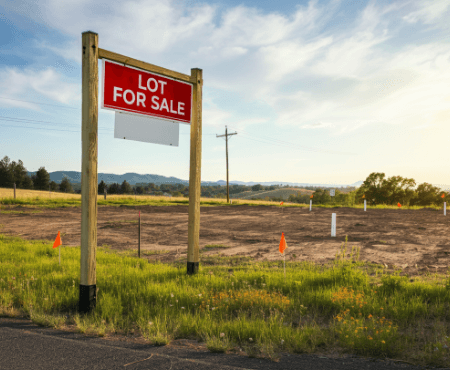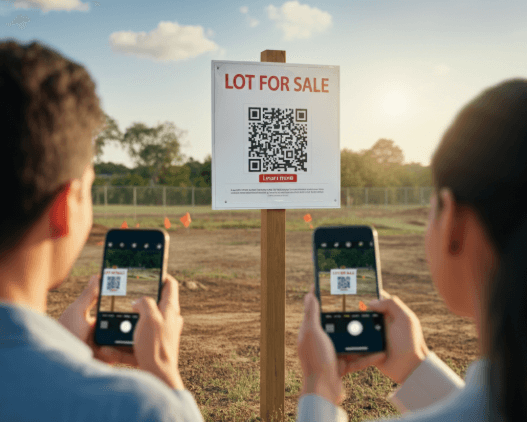Your property’s “For Sale” sign is one of your most powerful marketing tools, with studies showing that nearly half of all buyers use information from on-site signs during their search. A well-designed sign does more than announce availability; it serves as a 24/7 salesperson, capturing the attention of drive-by prospects and generating direct inquiries. The secret lies in making a “Lot for Sale” sign that is clear, compelling, and professional. Steve Daria and Joleigh, experienced cash land buyers, know which signs get noticed. Effective strategies for making a “Lot for Sale” sign can dramatically increase your call volume and lead to faster offers. This guide shares proven tips to ensure your sign works as hard as you do. To get personalized advice on your specific property and how to market it effectively, book a free discussion with our team today.
What is the best size for a lot for sale sign?
Choosing the best size for your sign depends heavily on its location and the speed of nearby traffic.
While common sizes like 18″x24″ work for slow residential streets, you will need a larger 24″x36″ or even 36″x48″ sign for faster roads to ensure drivers can read it.
For signs, a general guideline is one inch of letter height per ten feet of viewing distance, meaning properties with deep setbacks need larger signs.
Properly making a “Lot for Sale” sign also involves using high-contrast colors and plenty of whitespace to make your text pop.

The sign’s placement is just as important as its size; the bottom should be positioned about three to four feet above the ground to clear vegetation and be at eye level for drivers.
Before finalizing any plans, always check local city codes or HOA rules, as they may have specific limits on sign dimensions.
Once your sign is created, test its visibility by parking across the street and also by driving past it at the posted speed limit.
This final check ensures your contact information is perfectly legible to any potential buyer.
Get Started: Get Your Cash Offer Below…
We are direct land buyers. There are no commissions or fees and no obligation whatsoever. Start below by sharing where your property is and where we can send your offer…
What kind of material should I use for a durable outdoor sign?
Selecting the right material is crucial for creating a sign that can withstand outdoor elements like sun, rain, and humidity.
For short-term needs, lightweight corrugated plastic (coroplast) is a popular and budget-friendly choice.
If you expect your property to be on the market longer, aluminum is an excellent long-lasting, rust-proof option, while MDO plywood offers a rugged, premium look that holds up well.
Mid-tier materials like PVC and Aluminum Composite Material (ACM) also provide a great balance of durability and cost, far outperforming flimsy poster board.
When making a “Lot for Sale” sign, be sure to use UV-resistant inks and consider adding a laminate coating to prevent fading from the sun.
For enhanced nighttime visibility, reflective vinyl is a smart upgrade.
To handle wind, securely mount your sign using sturdy metal posts and reinforced grommets.
Ultimately, your choice should be based on your expected sale timeline and local weather conditions, so always confirm local rules before installing your sign.
What essential information must be on my sign?
- A Clear Headline: Your sign’s main purpose is to announce the property is available, so start with a bold, can’t-miss headline like “Lot for Sale” or “Land for Sale.” This immediately tells passersby what the opportunity is without any confusion.
- A Large, Readable Phone Number: The most critical element after the headline is a clear contact number, as this is how you will get leads. When making a “Lot for Sale” sign, ensure the phone number is the largest text on the sign besides the headline itself.
- Key Property Details: Include essential information, such as total acreage or square footage, to provide buyers with context on the lot’s size. Highlighting unique features like “Zoned for Retail” or “Waterfront Access” can attract more qualified prospects.
- A Simple Call to Action: Guide potential buyers on what to do next with a direct instruction like “Call for Details” or “Text for Info.” Effectively making a “Lot for Sale” sign can include a QR code linking to a webpage with photos and surveys.
- Optional Information: While not essential, adding a price can help pre-qualify buyers, though it may reduce the total number of calls you receive. You can also include a website URL or a unique property ID if you have a more detailed online listing.

Should I put a price on my lot for sale sign?
Deciding whether to include a price on your sign is a strategic choice with clear trade-offs.
Putting a price on the sign can save you time by pre-qualifying buyers and reducing calls from people who cannot afford your property.
However, leaving the price off encourages more inquiries, giving you the chance to speak with a wider range of potential buyers and explain the lot’s value directly.
The best strategy often depends on market conditions and your willingness to negotiate.
When making a “Lot for Sale” sign, remember that adding a large, readable price can sometimes clutter the design.
You can also display a “Call for Price” message or use a QR code that directs customers to a more detailed online listing.
If you do list a price, ensure it stays consistent with all your other marketing materials and update the sign promptly if you make a price change.
Ultimately, you should choose the approach that best fits your goals, whether that’s getting the most calls possible or achieving a faster, more qualified sale.
Are there local rules or city codes for placing signs?
- Check for Permits and Time Limits: Most cities and counties have specific rules, and some may require a temporary sign permit or limit how long your sign can be displayed. Always check with your local code enforcement or planning department before placing your sign to avoid any issues.
- Follow Size and Height Restrictions: Local ordinances often dictate the maximum allowed size and height for real estate signs to maintain community appearance and safety. When making a “Lot for Sale” sign, you must ensure its dimensions comply with these local regulations.
- Respect Setback Requirements: Your sign must be placed a certain distance away from the road, known as a setback, to avoid obstructing traffic views or public right-of-ways. Placing your sign entirely on your own property and well back from the street line is the safest approach.
- Adhere to HOA or Private Community Rules: If your lot is in a neighborhood with a Homeowners Association (HOA), they likely have their own strict rules that can override city codes. Before making a “Lot for Sale” sign, review your HOA’s covenants for specific guidelines on design, placement, and materials.
- Avoid Prohibited Locations and Fines: Never attach signs to utility poles, streetlights, traffic signs, or place them on public medians or sidewalks. Placing signs in these prohibited areas can lead to immediate removal and costly fines from the city.
What do I do once I have an accepted offer or the property sells?
Once you have an accepted offer, your focus shifts from marketing to managing the closing process.
First, add a “Pending” or “Under Contract” rider to your sign to stop new calls and update any online listings accordingly.
You should immediately confirm the closing timeline with the title company and closely monitor all contractual deadlines for inspections, surveys, and financing.
This is a critical step that follows the initial work of making a “Lot for Sale” sign that successfully attracted a buyer.
Coordinate with the buyer to provide access for any necessary appraisals or due diligence activities, and ensure utilities remain active until the sale is final.
After the property officially closes, remember to remove the sign promptly to comply with local rules and as a courtesy to the neighborhood.
Working with seasoned cash land buyers and real estate investors like Steve Daria and Joleigh can help ensure a smooth transaction from offer to closing.
To get help navigating the final steps of your sale, book a free discussion with our experienced team today.
Takeaway
- Use Bold, Readable Fonts: Ensure your sign is easy to read from a distance. Choose bold, high-contrast fonts and limit the amount of text so drivers and passersby can instantly understand the message.
- Include Essential Information Only: Avoid cluttering the sign. Stick to the basics: “Lot for Sale,” lot size (if applicable), a contact number, and possibly a short call-to-action like “Call Now” or “Owner Financing Available.”
- Choose High-Quality, Weather-Resistant Materials: Outdoor signs in areas like Miami must withstand sun, wind, and rain. Invest in durable materials like corrugated plastic or aluminum and use UV-resistant ink to maintain visibility over time.
- Add Visual Appeal with Color and Design: A splash of color—like red or yellow—can catch the eye. Keep the design professional but attractive to make your sign stand out from others in the area.
- Place the Sign Strategically: Position your sign where it’s clearly visible from the road, ideally at eye level. Make sure it’s not blocked by trees, fences, or other obstructions to maximize exposure.
**NOTICE: Please note that the content presented in this post is intended solely for informational and educational purposes. It should not be construed as legal or financial advice or relied upon as a replacement for consultation with a qualified attorney or CPA. For specific guidance on legal or financial matters, readers are encouraged to seek professional assistance from an attorney, CPA, or other appropriate professional regarding the subject matter.
